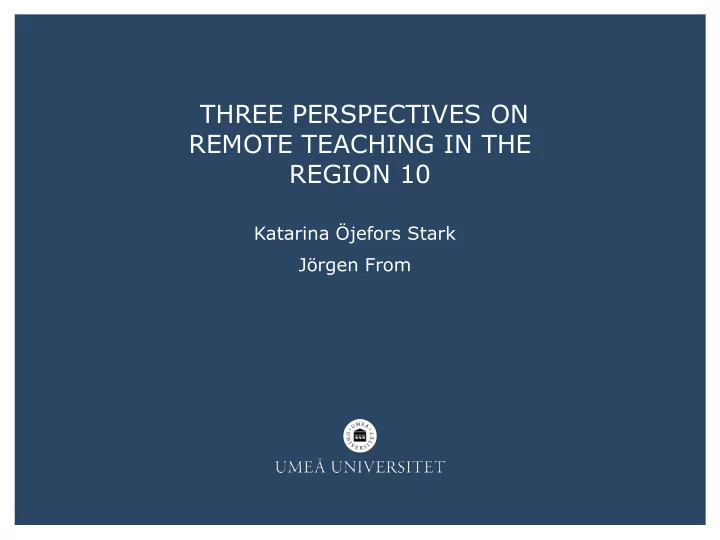

THREE PERSPECTIVES ON REMOTE TEACHING IN THE REGION 10 Katarina Öjefors Stark Jörgen From
THE FRAMEWORK ULF/DLR A complementary and symmetrical relation between practitioners, at different level, and researchers Underlines a dimension of development into research How to know the needs of a local school practice? How to identify and formulate a common part of departure? A qualitative interview study with School leaders and Regional officials from Region 10, and Researchers involved in ULF/DLR
BACKGROUND • Remote teaching, "... an interactive teaching that is conducted synchronously in real time with the help of ICT..." is currently regulated by Swedish law. • In rural Sweden, there is a growing interest in remote teaching. • Remote teaching is limited in compulsory school, compulsory school for pupils with learning disabilities, and the Sámi School to mother tongue tuition (referring to the tongues spoken from birth), Sámi, Modern languages, and Sign Language, as well as, study guidance in mother tongue tuition and integrated teaching in Sámi (The Education Act, 2010:800). • The Swedish National Agency for Education views remote teaching as a way to meet teacher shortage. • Lack of Swedish research on remote teaching as an educational form.
AIM AND RESEARCH QUESTIONS The purpose of this study was to investigate opportunities and challenges with remote teaching from three perspectives: school, region, and research. The research questions (RQ) were: 1. What opportunities can be identified within the three perspectives? 2. What challenges can be identified within the three perspectives? 3. What differences can be identified between the three perspectives?
METHOD AND ANALYSIS • Purposeful sampling • Eleven in-depth semi-structured interviews, 20-30 minutes each • School leaders ( N =5) (SL), Regional officals ( N =3) (RO) and Researchers ( N =3) (R ) Content Analysis of qualitative interviews •
METHODS AND ANALYSIS Methods Analysis Semi- Sampling structured Qualitative Content Participants interviews process analysis enrollment (N=11) samling, contact phone interviews coding,thematization, Invitation email transciption analysis 2nd invitation
OPPORTUNITIES WITH REMOTE TEACHING Statements within theme Themes Equality ”…for students to receive an equal education…” (RO2) Qualified teachers "... opportunity to offer teaching of qualified teachers and have qualified teachers... " (SL 1). Meet the teacher shortage ”... An overall perspective on the possibility of remote teaching at the macro level is to give students the opportunity to equivalent teaching as they are taught by competent teachers... " (R1). Quality “Equivalence, availability, and closeness” (R2)
CHALLENGES WITH REMOTE TEACHING Themes Statements within theme “... There is regulation on remote teaching and it is Legal challenges not suitable today. We need a completely different kind of legislation " (RO1) “... Another way to work [...] Another way to teach [...] Practical and organizational There are other preparations for adapting the challenges teaching... " (SL 1) "... Remote teaching is very new. Many parts of the Learning and learning community school are from the time of the Old Compulsory School... " (RO3) "... Requires a secure process and research. It is Lack of research important to do research on remote teaching … So that we know it will be good... " (R 3).
DIFFERENCES BETWEEN THE THREE PERSPECTIVES Themes Statements within the theme “.. some pupils will benefit from a more rigid Pupil´s perspective environment...” (SL2) ”...part of the is not to just provide leaning [...] School´s mission to socialize the social aspects of school could be pupils forgotten...” ( SL1) “ … It is much more difficult for me to visit a Lack of evaluation tools remote classroom…” (SL5) Practical and organizational issues ”...classrooms will be looked up [not to be used for traditional teaching] if used for remote teaching….this will effect scheduling in the whole municipality...” (SL2)
SUMMARY All perspectives saw remote teaching as the only way to ensure pupils in rural areas the right to equal education and teaching quality. There is a consensus on remote teaching as an integral part of school. However: • Regional officials and researchers highlighted limited use by the Education Act was the foremost challenge. • School leaders highlighted technology, pedagogy, and organization as challenges. • School leaders look at remote teaching more from the perspective of their own school and pupils, while regional officers and researchers relate remote teaching more to a societal perspective and future opportunities.
REFLECTIONS ULF/DLR Research must pay respect to, and take into account for, to school leader’s perspective of their own schools and pupils, in other ways than before, in order to establish the dimension of development work Corona….. Transitions to various forms of home schooling and remote teaching No legal restrictions The need for research and development of remote teaching is more pressing than ever before.
Recommend
More recommend